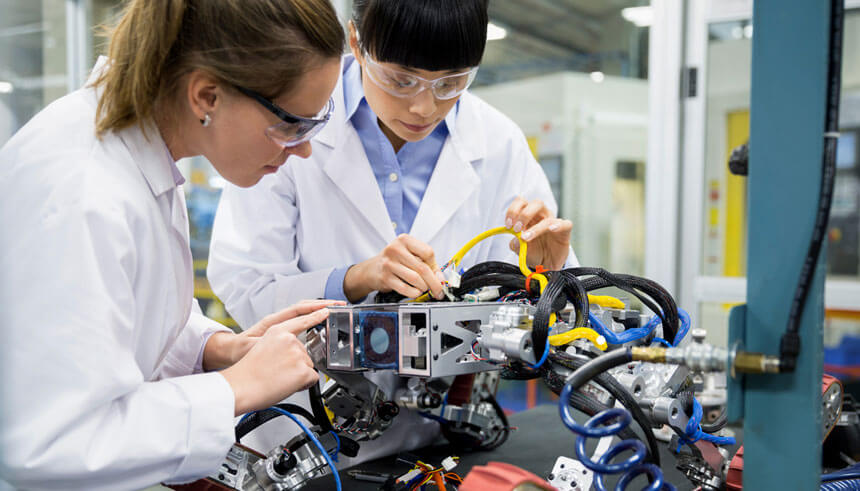US-Asia Business
US-China Market Watch: Trade and Artificial Intelligence

Roundup of the latest U.S.-China business and industry news.
Alibaba’s Ma urges open U.S.-China trade talks
Trade relations between the United States and China can become normalized, even after a rocky start under the new U.S. presidential administration, Alibaba Group Holding founder Jack Ma said at a recent trade summit.
Ma made his comments at the U.S.-China Business Leaders Summit in Washington D.C. in July, according to China Daily. It was the first such event and included representatives from leading Chinese businesses and U.S. organizations, such as private equity giant Blackstone Group.
The business leaders who attended the event agreed to establish a regular dialogue as a way to underscore the importance of maintaining open ties between the two countries, China Daily reported.
Ma singled out his own evolving relationship with President Trump as an example of the need for business leaders to keep talking.
“The good thing is that I think President Trump listens," Ma said at the Summit. "Initially, President Trump and I had different viewpoints. After I talked with him, he thought what I said made sense. Then I found out he did change and now follows a path that leads to a better way."
China aims to be world leader in AI by 2030
The Chinese government has made its plans to become a global leader in artificial intelligence known; by 2030, China aims to build a domestic artificial intelligence (AI) industry worth $150 billion.
The plan includes pouring funds into startups, academic research, and “moonshot projects” in AI, hopefully pushing the country to the technological forefront. Support for AI ranges from agriculture and manufacturing uses, to advancing homeland security.
Chinese investment in AI isn’t just limited to domestic companies—the United States Department of Defense says that Chinese firms have been putting money in American AI startups, according to the New York Times.
Role reversals in apparel and textile trade
Speaking of open trade, representatives from U.S. and Chinese textile manufacturers recently met in New York and discussed how roles are being reversed.
No longer is the old adage true that clothes sold in the United States are made in China but designed in North America, China Daily reported. Instead, Chinese textile firms are opening manufacturing and research facilities in America, and U.S. fashion trendsetters are taking some of their cues from China designers.
“There is a great potential for practical cooperation and complementarity in China and the United States, and big promises for win-win cooperation in the future,” Xu Yingxin, vice president of the China National Textile Apparel Council.
The comments were made at the 18th Annual China Textile and Apparel Trade Show in New York.
Xu noted that many Chinese textile businesses have made investments on American turf, setting up research and development (R&D) and manufacturing facilities covering a range of industry needs, including chemicals, fibers, and cotton textiles.
At the same time, U.S. designers like Jones New York and Andrew Marc are culling Chinese companies for ideas.
“We feel that more Western clients are taking interest in our designs—the newer, trendier and unique designs,” said Nicholas Zhou, sales representative for Aiyimei.
Wealth managers asked to back off yield increases
Chinese authorities have asked banks to lower their offered rates on certain wealth management products as a way to manage risk.
The China Banking Regulatory Commission told companies that the order applies to on-balance sheet products, Bloomberg reported.
Chinese lenders had pushed yields on these products to a 17-month high to offset the funding squeeze that came as a result of China’s ongoing effort to reduce leverage. By passing on higher yields, regulators are worried that the higher funding costs are being passed on to borrowers, which would threaten economic growth.
New Beijing airport could upend airline market
The mega-airport under construction near Beijing could cause major upheaval to Air China’s traditional market dominance, Bloomberg reported.
Air China has long dominated the Beijing air market. But the new $12.9 billion airport, slated to open in 2019, is being designed by Zaha Hadid Architects, and will serve as the hub for China Eastern and China Southern; those two carriers will each be granted 40 percent of the airport’s passengers. That will give them coveted air slots to the United States and Europe.
Still, Air China will still enjoy dominance at the existing main Beijing airport, which is located closer to downtown. It could be similar to how British Airways continues to lead the London air market by maintaining its hold on Heathrow airport, which is closer to downtown than London’s other airports.
Sign up for the Reach Further Newsletter
We’ll keep you in the know about the latest US-Asia business news and trends.
Suscríbase al boletín Reach Further
Lo mantendremos informado sobre las últimas noticias y tendencias comerciales entre Estados Unidos y China.

